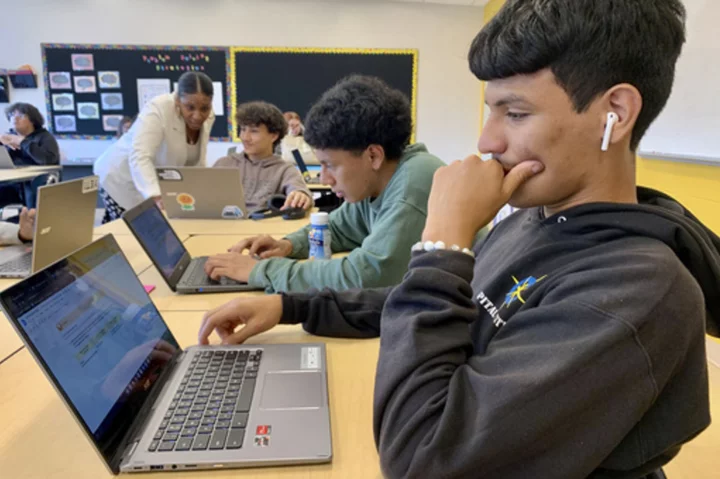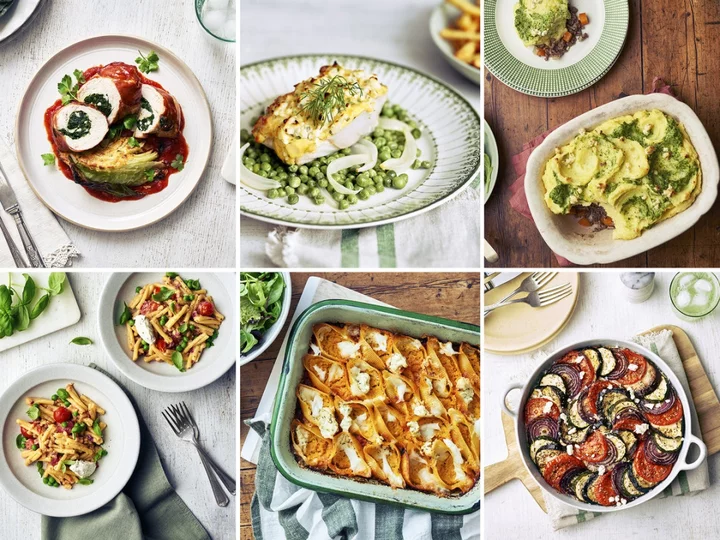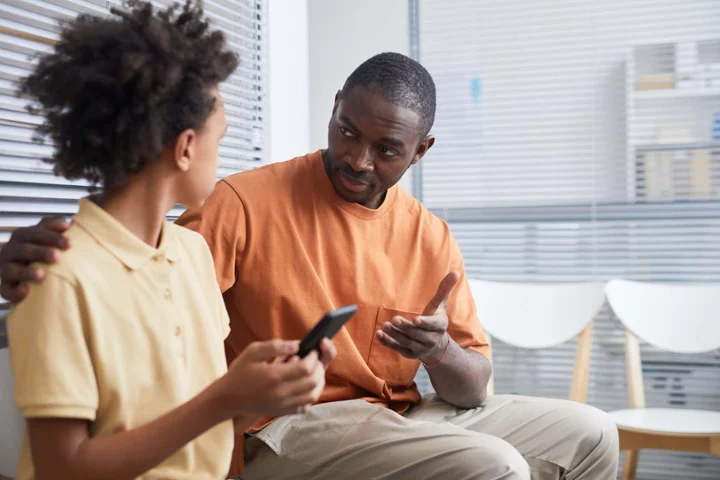
Israel-Hamas conflict: How to talk to teenagers about distressing news stories
With all the access teenagers today have to the internet and social media, they may see more distressing news stories than even their parents. Palestinian militant group Hamas – deemed a terrorist group by the UK Government – invaded Israel on Saturday from Gaza, with rocket attacks by air as well as military in boats. Since then, Israel has sealed the Hamas-ruled Gaza Strip off from food, fuel, medicine and other supplies, while launching retaliatory air strikes on the territory, which is home to 2.3 million people. The most recent numbers suggest 900 people have been killed in Israel, 700 in the Gaza territory and the West Bank, and many hostages have been taken. Hamas has pledged to kill captured Israeli hostages if attacks target civilians in Gaza. The conflict has sparked protests by pro-Palastine and pro-Israel groups in the UK and prompted political division on social media. Teenagers are likely to be exposed to a lot of the news, internet discussion and perhaps distressing images of conflict. So how should parents approach this? Talk about it at home Dr Jeri Tikare, clinical psychologist at Kooth, a digital mental health platform, believes parents should be as truthful as they can with their teenagers. “This means that it is important for us to not to hide things away from them. It is better for them to hear it from us (their people of safety) as opposed to reading it or hearing it from others,” he says. “Also bearing in mind the curious nature of the mind. It is inevitable that for things that they do not understand, they might research and look for answers. “It can be helpful if they get their information from a reliable source which can feel contained and reassuring. But share information at a level that is developmentally right and just enough to help the young person feel contained and safe.” Check yourself As the parent, learn the basics of what is going in the conflict yourself from reputable sources so you can have balanced, informed conversations with your child. “It can also be useful to be aware of our own reactions as parents or primary caregivers,” he says. “One of the ways young people learn and develop is via observing and then modelling adult behaviour. Hence, they can pick up anxieties or worries displayed by parents.” Validate and normalise expressing emotion If your teen is particularly affected by distressing news stories about war and conflict, Tikare encourages parents to give their teenagers the opportunity to express how they are feeling in different ways – such as writing, drawing, stories, songs, and things that feel helpful for the young person. “Some find a feelings box helpful,” he adds. “It might also be helpful to introduce them to some simple relaxation techniques such as taking three deep, slow breaths, breathing in for a count of three and out for three.” Be there for them Giving your teenager the space, time and encouragement to open up about how they feel on any subject – world news or otherwise – is key. “I know that life can be hard, busy and sometimes young people are aware of this and might not want to disturb you,” Tikare says. “Therefore, it might be helpful to make a conscious effort to let them know that you are mindful of how difficult it can be and reassure them that you are available to talk about things. “Giving them extra love and attention at this time can be helpful, especially at difficult times like this.” Discuss social media Tikare acknowledges that television, social media and other platforms “can be very distressing and exacerbating” for teenagers. But you may not be able to prise your child away from posting on their social media accounts altogether. “It would depend on the motivation behind posting and where they are posting,” Tikare says. “Posting about the feelings experienced around the conflict in a supportive and possibly moderated space, with people sharing similar feelings associated with the conflict, can help normalise the experience and leave them feeling less alone. “On the other hand, it could also expose them to content and comments that could potentially trigger distress.” So be sure to make them aware of the content they may come across online. Read More Autumn décor ideas for a seasonal refresh Why you shouldn’t tidy your garden too much in autumn World Mental Health Day: 5 ways to beat anxiety and change your life Alternative veg to grow for next season How to spot if your child is struggling with their mental health – and what to do next Does your pillowcase make a difference to your skin and hair health?
2023-10-10 20:51

Michelle Keegan 'doesn't follow' any fashion trends
Michelle Keegan "doesn't follow" any fashion trends and insists she prioritises comfort above all else.
2023-10-10 20:29

Scarlett Johannson 'struggled' with acne: 'Looking back at old photos was so painful!'
Scarlett Johannson "struggled" with acne during her youth but now finds it "rewarding" to have her own skincare line.
2023-10-10 19:58

Dollars and sense: Can financial literacy help students learn math?
More states are requiring personal finance education before students graduate from high school
2023-10-10 19:18

World Mental Health Day: 5 ways to beat anxiety and change your life
Anxiety is something that touches most of us, to a greater or lesser extent. Although it may just be a temporary blip for some people, for many, anxiety is a diagnosed condition that blights their lives. Indeed, Mental Health UK estimates more than one in 10 people in the UK are living with an anxiety disorder – that’s over eight million of us. And World Mental Health Day (October 10) is a chance to address the topic, agrees clinical psychologist Dr Kirren Schnack – author of the new book Ten Times Calmer: Beat Anxiety And Change Your Life. “It’s a reminder that mental wellbeing is just as important as physical health,” she says, pointing out that anxiety disorders are among the most widespread mental health issues globally. “Clinically, I’ve seen more and more people coming in with anxiety issue. The pandemic has played a significant role in this surge, introducing unprecedented levels of uncertainty, fear, and social isolation. At the same time, global economic instability and job losses have intensified stress and anxiety for many,” Schnack adds. “The widespread use of digital technology and social media has exposed people to a constant stream of alarming news and comparison-driven content that also feeds anxiety.” Schnack explains that anxiety disorders include generalised anxiety disorder (GAD), which causes chronic worry and hinders decision-making; health anxiety, where there’s an excessive preoccupation with diseases and illness; panic disorder, which is marked by sudden overwhelming panic attacks; and social anxiety, which leads to avoidance, isolation and low confidence. “They can blight daily life through physical symptoms, cognitive impairment, social isolation, disrupted routines, and emotional distress,” she says. Schnack suggests these five ways to combat anxiety problems and find calm… 1. Calm your stressed nervous system Anxiety places significant strain on the nervous system, Schnack explains, but there are simple daily practices that can help alleviate this stress. One is focusing on breathing, extending your exhale longer than your inhale. To do this, Schnack says you need to inhale gently through your nose, pause for a few seconds, then exhale slowly and deeply, ensuring an extended exhale. “A longer exhale helps by increasing the activation of the body’s parasympathetic nervous system, which counteracts stress hormones, lowers heart rate, and reduces overall physiological stress,” she says. She suggests around three to five of the breaths are repeated on multiple occasions throughout the day, and stresses that consistency is key. “Recognise that if anxiety has been a longstanding presence, it will take time and patience to restore your nervous system’s sense of safety and stability.” 2. Address anxious thoughts Schnack explains that anxiety often generates anxious thoughts that can seem like undeniable facts that are often dwelled on and reacted to, thus intensifying anxiety. “To break free from this cycle, it’s crucial to consciously confront and process these anxious thoughts,” she says. To do this, write a simple record, noting the date of your anxious prediction, describing what it was, and then, after a specified time like a day or two, return to what you’ve written and confirm whether the prediction was accurate by marking it as ‘yes’ or ‘no’. When the prediction doesn’t materialise, make a note of the actual outcome. Revisit the record, especially during anxious moments, and count the yes or no entries to reflect on your progress. “This practice trains your mind to adopt a broader, less anxious perspective,” explains Schnack. 3. Stop over-focusing on anxiety“People struggling with anxiety often find it challenging to shift their attention away from anxiety symptoms, leading to a persistent preoccupation that can worsen their problems,” says Schnack, who explains that this preoccupation can lead to excessive self-analysis, fixation on physical sensations or repetitive thoughts, and being hypervigilant. To shift your attention away from overwhelming anxiety, Schnack suggests trying this exercise: choose a colour, such as blue, and actively seek out blue objects in your surroundings. Name them out loud, and count them as you move around, possibly describing the item too. “Strive to maintain this focus for a few minutes, switching to different colours if necessary. Again, consistency is crucial, so make an effort to practice this regularly whenever anxiety hijacks your attention,” she advises. 4. Learn to tolerate uncertainty Recognising and addressing uncertainty is vital when dealing with anxiety, Schnack stresses. “You can’t resolve every uncertainty in life – the key lies in enhancing your ability to tolerate uncertainty so you can reduce your anxiety,” she explains. “Being more accepting of the fact that things may not always go as planned or that the future is uncertain can be incredibly liberating.” To help build resilience against uncertainty, Schnack advises people to take a moment to slow down and not immediately engage in reactive behaviour demanded by uncertainty, such as checking, Googling or avoiding things. Instead, she says, note your feelings, observing what uncertainty is doing to your mind and body, and write out an affirmation such as: ‘I’m feeling anxious because I’m uncertain about… My typical response to uncertainty is to engage in… behaviour. I recognise this only worsens my anxiety. My goal is to distance myself from anxiety rather than gravitate towards it. I can sit with the feeling of uncertainty for as long as I can, and build on this time until I get better and better at it.’ 5. Gradually face your fearsConfronting your fears is an effective way to overcome them, observes Schnack, although this can often feel overwhelming. “When you confront your fears, you’re essentially acting in opposition to your anxious thoughts and what anxiety is telling you. This process weakens anxiety’s grip on you, and when the actual outcomes don’t align with your anxious predictions, your mind can naturally adjust its thinking.” She suggests starting with small steps and gradually building up. So, for social anxiety, gradually start by saying a simple sentence or asking a basic closed question, and gradually building up from there. For health anxiety, gradually reduce and eliminate excessive online researching about illness and diseases, starting with small-time durations and then building on that. For panic disorder, gradually spend more time in places you typically avoid, starting with short durations like 30 seconds, then a few minutes, and gradually keep increasing the time. “Remember to repeatedly face your fears to make meaningful progress – it’s not just a one time thing,” adds Schnack. Ten Times Calmer: Beat Anxiety And Change Your Life by Dr Kirren Schnack is published by Bluebird, priced £16.99. Available now. Read More Alternative veg to grow for next season How to spot if your child is struggling with their mental health – and what to do next Does your pillowcase make a difference to your skin and hair health? Sarah Jessica Parker channels Carrie Bradshaw on the red carpet in mismatched shoes Does your pillowcase make a difference to your skin and hair health? As transphobic hate crimes rise by 11% in a year, how to be a better ally
2023-10-10 14:20

Obsessed with Boursin? It’s the perfect way to elevate your leftovers
We threw away 68,000 tons of perfectly good food over the summer. Let that sink in for a moment. Overstocking, the heat, spontaneous social plans and having less motivation to cook were some of the main culprits, according to new research by Boursin. The most commonly wasted ingredients included sad vegetables, soggy pasta, wilted salad leaves and stale bread. Surprisingly, chicken, fish and even cheese made the top 20 list of frequently wasted foods. In an effort to put a stopper in this cycle, Boursin has teamed up with Great British Bake Off star Manon LagreÌ€ve to serve up simple solutions for reducing food waste. Aimed at the 67 per cent of us who prefer to cook simpler and less time-consuming dishes through simple family friendly recipes, LagreÌ€ve’s recipes showcase how British culinary classics can be easily elevated with the nation’s favourite indulgent cheese, Boursin, and a unique French twist. So dig out the leftovers from the fridge, grab a pack of Boursin, and get cooking. Vegetable Provencal Boursian tian Serves: 4-6 Ingredients: 150g of dry rice 2 tbsp of Boursin Garlic & Herbs, plus 1 tbsp to top the Tian with 2 tbsp of olive oil 2 courgettes 1 aubergine 6 tomatoes 1 red onion 3 cloves of garlic 2 tsp of herbes de Provence Salt and Pepper Method: 1. Slice the aubergine and place face down in the tin, generously season with salt and leave to soak and release moisture. 2. Place the rice in a pan, with 300ml of water, ½ tsp of salt, cover and bring to boil. Once it is boiling, remove from the heat and leave for 10 minutes covered. 3. Wash and slice courgettes, tomatoes, onions and garlic. 4. Rince the aubergines, pat dry with a kitchen towel and brush with some olive oil. 5. Pre heat the oven to 180C fan oven. To assemble the Tian, drizzle some olive oil at the bottom of the tin, spread the cooked rice and crumble the 2 tbsp of Boursin on top. 6. Cover the rice with the vegetable slices, tomato, courgette, aubergine, onion, garlic then drizzle with olive oil, herbe de provence, and season well with salt and pepper. 7. Cook for 45 minutes to 1hour and serve hot! Almond and Boursin grilled cod, with frites and peas Serves: 4 Ingredients: 4 filets of cod, skin off 50g of shaved almonds 2 tsp of Boursin Garlic & Herbs 1 egg 1 tbsp of breadcrumbs Fresh chives 1kg of potatoes 45ml of vegetable oil 500g of fresh peas 1 medium onion 2 tsp of salted butter 3 garlic cloves 2 tbsp of mayonnaise 1 tbsp Boursin Garlic & Herbs Salt and pepper Method: 1. Start by peeling the potatoes and cutting them into thin French Fries. Place them in a large bowl of hot water and leave them to soak for 10 minutes. 2. Preheat the oven to 220C. 3. Rinse and pat dry. Add the vegetable oil, 1 tsp of coarse salt and mix with your hands. Transfer to a large roasting tin to create one layer. Put a timer on for 20 minutes. 4. In the meantime, prepare the crust by mixing the almonds, Boursin, eggs and the egg. 5. Slice the onions and place in a roasting tin with the peas, garlic and salted butter diced. Add the cod on top of the peas, season with salt and pepper then divide the crust and spread it on top of the cod. 6. Use a spatula to mix the French fries in the oven and place at the bottom of the oven, turn the temperature down to 210C and cook for 10 to 12 minutes. 7. Make the Boursin mayo and serve the fish on top of the peas, add some dill and the French fries. Voila! Creamy plant-based Boursin pasta (vegan) Serves: 4 Ingredients: 400g of dry pasta (or leftover cooked pasta) 100g of fresh peas cooked. 100g of pine nuts 300g of cherry tomatoes 1 pack of Boursin Plant-Based (130g) 2 tbsp of olive oil ½ red onion A small bunch of fresh basil Salt and pepper Method: 1. In a pan, fry the diced onions with the olive oil for a couple of minutes, then add the cherry tomatoes and fry for 3 minutes. 2. Use a spatula to pop in some of the tomatoes. Add the pine nuts and a couple of tbsp of water if needed. Season with salt and pepper and set aside. 3. Cook the pasta in salted water respecting the package instructions. 4. Remove the sauce from the heat, mix the Boursin in with a fork in a bowl, then add to the tomato sauce. Finally pour the just cooked pasta over the top. 5. Serve the pasta, top with some peas, a tsp of plant-based Boursin and some fresh basil. Boursin and spinach stuffed chicken roulade Serves: 4 Ingredients: 4 chicken breasts 300g of baby spinach 2 tbsp of breadcrumbs 100g of Boursin Garlic & Herbs 4 slices of Jambon de Bayonne or Parma ham 1 big white cabbage 2 tbps of salted butter at room temperature 2 tbsp of Boursin Garlic & Herbs 500ml of boiling water 2 tbsp of olive oil A sprinkle of parsley Method: 1. Place the baby spinach in a colander and pour the boiling water over to cook it. Then press it against the colander to remove as much moisture as possible. 2. In a bowl, mix the cooked spinach, breadcrumbs and Boursin to make a paste. 3. Spread a chicken breast, then slice the thicker side from the inside to extend the chicken breast and make it thinner and larger. Spread 1 tbsp of the Boursin mix in the middle and roll the breast to make a tight roulade. Then wrap the chicken breast with the Parma ham and place in an oven dish. Repeat with the rest of the chicken breasts. Set aside in a roasting tin. 4. Pre heat the oven to 200C fan. 5. Cut the cabbage into wedges and dip in water to add moisture. Drizzle a roasting tin with olive oil and place the wedges on top. Mix the Boursin and butter together and brush it over the cabbage wedges. Season with salt and pepper. 6. Place the chicken on top of the oven shelf and the cabbage at the bottom and roast for 30 minutes. 7. Baste the chicken with the juices a couple of times through cooking. 8. Serve hot and sprinkle with parsley. Boursin and butternut squash filled conchiglioni (vegetarian) Ingredients: For the stuffing: 500g of squash or pumpkin, diced skin off 1 tbsp of olive oil 100g of parmesan 100g of Boursin Garlic & Herbs For the sauce: 2 cans of good quality diced tomatoes 4 garlic cloves 1 vegetable stock cube 1 tbsp of sugar 1 tsp of dried oregano 1 bunch of fresh basil Salt and pepper 2 tbsp of olive oil Extras/alternatives: Mozzarella Extra Boursin Garlic & Herbs 500g of large conchiglioni Method: 1. Pre heat the oven to 220C and roast the squash with the olive oil for 30 minutes until tender. 2. In the meantime, start to make the sauce. Add the olive oil and the diced garlic and fry on medium heat for a few minutes, add the oregano and half of the fresh basil and fry for another minute. Add the canned tomatoes, the stock cube and 100ml of water. 3. Add the sugar and leave to simmer on low heat until the end of the recipe. 4. In a blender or a food processor, add the rest of the stuffing ingredients and the roasted squash and season then, blend for a minute. Pour that into a piping bag. 5. Season the tomato sauce to taste with salt and pepper. Optional, you can use your food processor to blend it to a smooth sauce if you wish. 6. Pour the tomato sauce onto an oven dish and start to fill up the Conchiglioni one by one, simply using the piping bag. Spread the filled Conchiglioni on top of the tomato sauce. 7. Top with the mozzarella and crumble some Boursin. Cover with tin foil. 8. Cook for 40min at 200C covered, then remove the foil and cook for another 10 minutes. Boursin hachis parmentier Ingredients: 500g of mince beef 1 shallot 1 onion 3 carrots 2 cloves of garlic 30g of butter Salt and pepper 1kg of potatoes 50g of butter 200ml of warm milk ½ tsp of nutmeg 1 broccoli 100g of Boursin Garlic & Herbs, plus extra to crumble Method: 1. Peel and dice the potatoes and transfer to a large pan, cover with cold water, generous amount of salt for 30 minutes. 2. Dice the carrots, onion, shallot and garlic. Heat up a pan, add the 30g of butter and the carrots, onion, shallots and garlic. Fry for a few minutes until softened. 3. Add the minced beef to the pan and cook for 10 minutes. Season with salt and pepper. 4. Transfer the meat to your oven tin and set aside. 5. Boil and cook the broccoli in salted water for 8-10 minutes. Drain the water, then mash the broccoli with a masher or a fork and add the Boursin to it. 6. To make the purée, drain the water from the potatoes, then add the warm milk, the 50g of butter and season well with salt and pepper. Mash the potatoes with a masher to make the purée. 7. Preheat oven to 220C fan. 8. To finish the Hachis, spread the purée on top of the mince, spoon the broccoli on top of the purée and make some swirls with a fork. Sprinkle some Boursin on top. 9. Place in the oven for 10 to 15 minutes and serve hot with a small, dressed salad. Read More Budget Bites: Three one-pan recipes that minimise on washing up Cold-weather recipes to get on your radar now How to cook to keep your gut healthy Three recipes from Michel Roux’s new fuss-free French cookbook Formula for the ‘perfect’ fish finger sandwich revealed Being vegetarian may partly be in one’s genes, study finds
2023-10-10 13:50

Elizabeth Hurley issues reminder to women about getting mammograms as she raises awareness about breast cancer
Elizabeth Hurley has issued a reminder to women about getting mammograms, in honour of her partnership with Estée Lauder’s Breast Cancer Awareness campaign. The model, 58, spoke candidly about mammograms – which are X-rays performed on women’s breasts to screen for cancer – during a recent interview withUs Weekly. While discussing her last 28 years as the ambassador of Estée Lauder’s campaign, she told women that if they feel something “abnormal” when examining their bodies, they shouldn’t hesitate to get it checked by a doctor. “I think the most important thing you can do is familiarise yourself with your breasts because they’re yours and only you know how they feel,” she said. “You should recognise something when it’s abnormal, and you should go to the doctor right away.” Hurley emphasised that annual screenings for breast cancer are not only “vital,” but they should be considered a part of “looking after your health in every way”. She also went on to urge women to be “breast cancer bullies” by continuing to encourage their loved ones to get checked for the disease. “Make sure your friends, your family, your mother, your grandmother, that they’re going for their screenings regularly and urge them to self-check,” she said. “It doesn’t discriminate. It can hit anybody. Some groups are more vulnerable than others.” She also made a reference to one breast cancer that can be difficult to treat, triple-negative breast cancer, which “differs from other types of invasive breast cancer” because “it tends to grow and spread faster, has fewer treatment options, and tends to have a worse prognosis”, as noted by the American Cancer Society. The type of cancer can also be “more common in women younger than age 40, who are Black, or who have a BRCA1 mutation”. “It disproportionately affects Black women,” the Bedazzled star added. “It’s a diverse disease and it needs to be attacked in a diverse way.” According to the American Cancer Society, women between the ages of 45 and 54 “should get mammograms every year”. Meanwhile, women who are 55 and older can either “switch to a mammogram every other year, or they can choose to continue yearly mammograms”. In addition, women between the ages of 40 and 44 “have the option to start screening with a mammogram every year”. The organisation also noted that breast cancer is the most common cancer in women, with estimates of “about 297,790 new cases of invasive breast cancer” being diagnosed in women in the US in 2023. Over the years, Hurley has continued to speak about the importance of getting a mammogram. Last year, she joined Loose Women hosts Kaye Adams, Brenda Edwards, Nadia Sawalha, and Carol McGiffin for a self-examination on live TV. During the segment, she also opened up about losing her own grandmother to the disease, and how her attitudes towards breast cancer have shifted over time. “At that time nobody talked about it. There was no pink ribbon, no Breast Cancer Awareness month,” the Serving Sara star said, adding that when her grandmother first found a lump in her breast, she didn’t go to the doctor because she was “scared and embarrassed”. “When she finally went it was quite progressed. But she still never talked about it,” the model continued. “It’s still a life-threatening disease for many women, but times have changed. We talk about it now.” During her interview with Us Weekly, she went on to celebrate her 28th year with Estée Lauder’s Breast Cancer Awareness campaign, noting that Estée Lauder’s daughter-in-law, Evelyn Lauder, is the one who first asked her “to get involved” with the mission. “That’s how it started, and I’m still here. We’ve raised $118m, 93 million of which went straight to research,” she said. “The rest went to education, medical services, support groups [and more]. It’s a phenomenal achievement.” Read More Big Brother narrator Marcus Bentley: Meet the man behind TV’s most recognisable voice ‘Not guilty’: Elizabeth Hurley reacts to rumours she took Prince Harry’s virginity Elizabeth Hurley slams British Airways’ ‘dodgy service’ after getting stuck in Antigua Like Sophie Anderton, I have felt the shame of struggling to have a child of my own How to spot if your child is struggling with their mental health – and what to do next How to get rid of bedbugs: Signs and symptoms amid threat of UK invasion
2023-10-10 05:20

Kimberly Palmer: How to plan for a potential inheritance
Baby boomers are poised to pass on an enormous amount of wealth to their children and grandchildren over the next two decades
2023-10-09 23:21

Ancient Roman sit of Pompeii is about to 'expand'
Pompeii, the ancient Roman city is set to expand. The Grande Pompei project, which will lay on free shuttle buses and shared tickets to other archaeological sites and villas in the vicinity.
2023-10-09 21:18

How to spot if your child is struggling with their mental health – and what to do next
Spotting when your child is struggling with their mental health, and knowing how to support them, can be tricky for parents and carers. It’s an important issue to be aware of, however. According to the Children’s Society, in the three years up to 2022, the likelihood of young people having a mental health problem increased by 50%, while children and young people’s mental health charity Place2Be says one in six children experience mental health difficulties, rising to one in four amongst 17–19-year-olds. Emotional disorders including depression and anxiety are among the most common problems to crop up. James Emmett, regional clinical lead at Place2Be, says although the Government has taken “great strides” to address the issue by introducing support teams and senior mental health leads in schools, “we’re still seeing a sharp increase in diagnosable mental health conditions among children and young people, now affecting one in six children – which is around five in every classroom”. Stevie Goulding, senior manager for parents and carers services at the charity YoungMinds, says: “More young people than ever are struggling with their mental health and are in need of support. This generation is facing a unique set of pressures – living through a pandemic, a cost-of-living crisis and ongoing global instability – and they’re worried about their future. “As young people navigate the ups and downs of growing up, recognising when to be concerned about your child’s mental health can be difficult.” Here, Goulding and Emmett outline how parents can spot whether their child may be struggling, and how to help… 1. Look for behaviour changes A change in behaviour is usually the first sign that a child or young person is feeling low, says Emmett: “They may eat too much or not enough, have problems sleeping, or stop doing things they normally enjoy.” Goulding adds: “If you notice changes in your child’s behaviour or if they appear persistently distressed, it could mean they’re struggling with their mental health, and it’s important to take their concerns seriously.” 2. Give them the opportunity to talk Goulding suggests parents try to talk to their child or teen about how they’re feeling in a non-judgemental way. “Remember, they might not want to open up at first, so reassure them you’re there for them when they’re ready to talk. Remind them it’s ok for them to feel scared or unsure, and try to reassure them,” she advises. 3. Don’t force them to talk However, Emmett says sometimes they may not want to talk, adding: “It’s important that adults don’t force them to have a conversation they don’t want to have. Parents and carers must make sure they’re available – but don’t pressure them to talk. “It can be really tempting to ask a lot of questions, but it’s easy to slip into interrogation mode. Try to focus on the here and now and what would help moving forward.” 4. Choose your momentAvoid discussing the underlying causes of your child’s distress with them during intense moments, Goulding advises: “While it’s crucial to provide support, it can be more beneficial to address these topics when they’re feeling calmer.” 5. Ask how they’re feeling Ask if your child notices when they feel more or less sad, for example, at school, or when they’re with their friends and family, suggests Emmett. “Responding sensitively to your child’s signals with concern and interest will help them learn you’re there for them,” he notes. Goulding says parents can acknowledge their child’s feelings by saying something like: ‘It’s completely understandable that you’re feeling…’. She explains: “This helps to reassure them their feelings are valid and it’s ok to feel different emotions.” 6. Remind them of obstacles they’ve overcome in the past When a child or young person gets overwhelmed, they forget just how much they’ve already dealt with in their lives. “Tell them stories about how proud you were when they coped with certain moments in their life, such as an sitting an exam, or moving house,” says Emmett. “This will remind them of their resilience – their ability to adapt to difficult situations.” 7. Encourage them to stay active Physical and mental wellbeing are often linked. “This means doing something active can be a great way to boost your child’s mental health, and heading outside into green space can have even greater benefits,” says Emmett. He suggests parents walk or cycle short distances with their child instead of going in a car: “It’s cheaper and will help the planet to be healthier too.” 8. Model positive relationships Happy relationships between parents and significant adults lead to better mental and physical health for everyone, stresses Emmett. “By modelling positive relationships of your own, you can help your child to see what positive, healthy and meaningful relationships should look like – and to recognise when friendships aren’t positive,” he says. 9. Remind them how they feel will change Your child might not be able to see the light at the end of the dark tunnel they’re in. “Reassure your child that how they’re feeling is temporary,” says Goulding. “Things can change and they can feel better.” 10. Discuss what help is available Talk to your child about the different sources of help that are available, such as helplines, text lines and online chat services. “Reassure them it’s alright to confide in others, as young people often worry about upsetting their parents,” says Goulding. As well as YoungMinds parents’ helpline (0808 802 5544) and Place2Be, other sources include your child’s school, which will have a designated senior mental health lead, your GP who can refer your child to CAMHS, Parenting Smart, which provides free advice for parents and carers of 4–11-year-olds on how to support their child’s wellbeing and behaviour, and the free Shout 24/7 textline for anyone in crisis (text SHOUT to 85258). Read More Does your pillowcase make a difference to your skin and hair health? Sarah Jessica Parker channels Carrie Bradshaw on the red carpet in mismatched shoes Does your pillowcase make a difference to your skin and hair health? As transphobic hate crimes rise by 11% in a year, how to be a better ally Impact of relationships with AI chatbot programmes ‘worrying’, psychologist says Pokemon’s Detective Pikachu Returns and more top games of the week
2023-10-09 14:47

What to stream this week: Jamie Foxx, Offset, Musk, 'Frasier' returns and Nicholas Cage as a vampire
This week’s new entertainment releases include Offset’s sophomore solo album, the return of “Frasier” starring Kelsey Grammer, and Jamie Foxx and Tommy Lee Jones leading the crowd-pleasing courtroom drama “The Burial."
2023-10-09 12:27

Schools' pandemic spending boosted tech companies. Did it help US students?
An infusion of federal pandemic relief to America's schools sparked a boom in the education technology sector, an industry where research and evidence are scarce
2023-10-09 12:27
